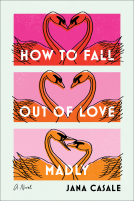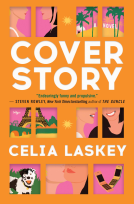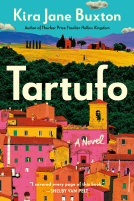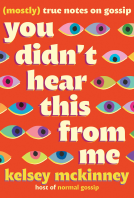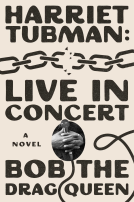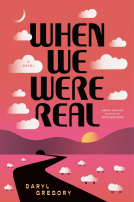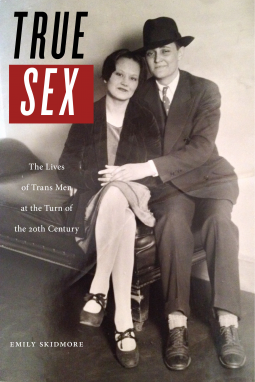
True Sex
The Lives of Trans Men at the Turn of the Twentieth Century
by Emily Skidmore
This title was previously available on NetGalley and is now archived.
Send NetGalley books directly to your Kindle or Kindle app
1
To read on a Kindle or Kindle app, please add kindle@netgalley.com as an approved email address to receive files in your Amazon account. Click here for step-by-step instructions.
2
Also find your Kindle email address within your Amazon account, and enter it here.
Pub Date Sep 19 2017 | Archive Date Oct 18 2017
Description
Winner, 2018 U.S. History PROSE Award
The incredible stories of how trans men assimilated into mainstream communities in the late 1800s
In 1883, Frank Dubois gained national attention for his life in Waupun, Wisconsin. There he was known as a hard-working man, married to a young woman named Gertrude Fuller. What drew national attention to his seemingly unremarkable life was that he was revealed to be anatomically female. Dubois fit so well within the small community that the townspeople only discovered his “true sex” when his former husband and their two children arrived in the town searching in desperation for their departed wife and mother.
At the turn of the twentieth century, trans men were not necessarily urban rebels seeking to overturn stifling gender roles. In fact, they often sought to pass as conventional men, choosing to live in small towns where they led ordinary lives, aligning themselves with the expectations of their communities. They were, in a word, unexceptional.
In True Sex, Emily Skidmore uncovers the stories of eighteen trans men who lived in the United States between 1876 and 1936. Despite their “unexceptional” quality, their lives are surprising and moving, challenging much of what we think we know about queer history. By tracing the narratives surrounding the moments of “discovery” in these communities – from reports in local newspapers to medical journals and beyond – this book challenges the assumption that the full story of modern American sexuality is told by cosmopolitan radicals. Rather, True Sex reveals complex narratives concerning rural geography and community, persecution and tolerance, and how these factors intersect with the history of race, identity and sexuality in America.
Available Editions
| EDITION | Other Format |
| ISBN | 9781479870639 |
| PRICE | $89.00 (USD) |
| PAGES | 272 |
Links
Featured Reviews
 Patty U, Reviewer
Patty U, Reviewer
This book was very interesting, and sad. Sad, because these people had to resort to lying and hiding themselves just to be happy and live their lives as they wanted to and that they were treated so badly for being different.
The book was well presented and it was fascinating how many actually managed to live long happy lives in the manner they chose for long periods of time undetected.
I am a huge nerd when it comes to queer anything. I am sadly lacking in my knowledge of FtM and transman history as it doesn't seem to be the topic of choice ever. When I saw this book up for grabs I freaked out. Finally a book that focused on my history. I wasn't going to be just a footnote in a book that is supposedly about trans people, but focuses on MtF people for 99% of the book.
The book was easy to follow, but a bit dense. It was clearly an academic piece. It was written at a level where it was just slightly above the reading level that I can tear through. It took me two sessions to finish, instead of my customary one when it comes to queer books. I was expecting more of a Transgender Warriors, but I was very happy with the book.
The book followed the lives of transmen as they were outed in the media in the late 1800's and early 1900's. The author used the local and national newspapers to piece together the stories of the lives of the men and to match up to current theories around gender, race, and identity. I appreciated the note that author had about terminology, but I hate the term "true sex". The implications are pretty nasty. If the author hadn't put it in quotation marks every time it was used, I would have abandoned the book assuming that it was transphobic. Thankfully the author made the language clear up front and showed a great deal of respect for the men she was discussing. My favorite sign of her respect was she constantly referred to the men as he and as men. She never took away their dignity. She had none of the issues I generally have with academic work done by someone who isn't trans (maybe she is trans, I don't know. I have not asked). Don't get me started on my issues with psychology research!
The book taught me a great deal and made me reevaluate the way I see smaller cities. This book gave me validation in my views of port cities (did I ever mention how much I hated living in the SF area despite the large queer presence?). I much prefer the smaller cities or towns. According to this book I might just be following the footsteps of many transmen. I doubt the academic work was meant to make me feel less alone, but somehow this book did just that.
4 out of 5 stars. I would recommend this book.
 Lexxi K, Reviewer
Lexxi K, Reviewer
<I>I received an ARC of this book from NetGalley and New York University Press in exchange for an honest review.</I>
This is a nonfiction book that attempts to examine the history of a segment of the LGBT rainbow that tends to get ignored, lumped in with other things, and/or assumed to ‘match up’ with ‘the rest’ of the found history. Specifically this is an examination of the T in LGBT. Though it is entirely fixated on FtM without even a hint that MtF exists – unlike L and G, which at least get a mention here and there – both in terms of similarities and differences inherent in what has been found by researchers. B? I? A? Not even mentioned.
The general idea of LGBT history research, or, I should say, the general narrative that has been found through research, is that ‘queer people’ are allowed to ‘blossom’, to really become themselves when they go the cities and join LGBT communities. With some exceptions here and there, like research that has been done about the American Western Frontier, the ‘best’ places for gay and lesbian individuals would be found within cities. It’s the ‘rural’ vs. ‘urban’ mythos. And an assumption was made that this would hold true for all LGBT peoples.
The author of this nonfiction book, though, has found that transgender history, at least as it relates to FtM (or female to male), is different than expected. Research has found that there has been a large number of, as the author puts it, ‘Trans Men’ who had found rich rewarding lives ‘being themselves’ in rural communities. There are certain reasons for that, which the author elaborates upon in the book. Though it is stressed… right.
Through mention of other histories and research done on the era (1870-1930), plus extensive research among many newspapers, the author presents her findings through, as noted, mention of other research, plus case studies. Mostly those found through newspaper articles from the era in question, plus a few sexology … case studies (I shouldn’t have used case studies before since it actually is ‘case studies’ there for the sexology thingie).
There are five chapters and many Trans Men are identified, described, and examined. Two things are immediately of importance – regardless of how the individuals identify themselves, the author focuses more on the Trans Men than anyone else they might be cohabitating with (though mention of girlfriends, wives, etc. occurs; including any husbands the Trans Men might have had along the way). Oh, and the second thing of immediate importance, there is an assumption being made, whether I’m reading into things or not I’m not sure, but an assumption made by the author that if a woman dresses up like a man, is found out and reported on in the news, then regardless of their own words, they are trans men (instead of, say, women who found that it was easier to find work and continue working while dressed men and putting themselves out there as men). Many of the same news articles I saw that had the trans men saying things like ‘I dressed like a man for work, but I plan to never again wear men clothing’ had later news reports about the same trans men who, oddly enough despite their own words, found themselves again ‘found out’ wearing men’s clothing. So there is evidence that what their own words say, they mean something else to themselves (especially since so many of them find it easier to present themselves in certain ways in the press to help with public opinion and/or court cases).
Right, so. Five chapters. And both a long extensive introduction, and a long extensive notes section (the book itself ends, the part before the end notes I mean, at about 70% into the ARC kindle file). Except for a chapter on marriage and what it meant over time; the chapters follow a progression, starting with chapter one set in the earliest years in the 1870s/1880s. And traveling through time up to chapter 4 and the 1920s/1930s. With chapter five concentrating on, as noted, the concept of marriage throughout the years.
There were many interesting tidbits of information gained along the way. One of which is that many of these stories would make good books. Which, in its own way, is quite important – as the impression given is that two women just couldn’t have any kind of relationship with each other ‘before’ a certain date. Just couldn’t be done. They’d be shunned by society. Then I read this book and I see couples that had 10, 20, 30 year marriages (and yes, some of these were legally sanctioned marriages – granted, one of the people in the marriage was dressed as a man and proclaiming themselves to be a man, and the other was dressed and acting like a woman when they got married). Opened my eyes, that did. Then there were more eye-opening moments.
Eye opening moments: it appears, from the extensive research conducted by the author of the book, rural communities were actually a lot more accepting of same sex unions involving two women. There’s many a story wherein the ‘true sex’ of the ‘female husband’ was found out and the local community responded positively towards the couple. True sex – that’s one of the things newspapers just loved to do: 1) act shocked and horrified when it is found out that the husband’s ‘true sex’ was actually that of a ‘biological woman’ (with wording that indicated that this was like the first time this has ever happened or been seen; then a similar story would pop up the next day with no links being made to the prior days story, odd, eh?); 2) call the husband in the relationship that involved a trans man a ‘female husband’ – sometimes positively, sometimes negatively.
But I was talking about rural communities. It seems, after research, that many rural communities were actually quite accepting of two women living together in a marriage like setting as long as: 1) one took on the role of husband; 2) the husband was hard working and a positive benefit to the community; 3) white (or, at least, ‘white enough’ depending). And no, they didn’t then pretend that it was man and woman; many a story had comments that indicated that yes they knew that that dude walking around in pants and who had a wife was 'in fact' a woman in men's clothing, they just didn’t care because both were fine upstanding members of the community. And stuff. And this was repeated all over the country. Fine upstanding member of the community? Fine, be woman-woman household (as long as one dresses and acts like a man); not upstanding member of community? Depends, but unlikely to be accepted. Likely to end up being punished and/or put in an insane asylum (as happened to one woman, though there is an indication that that specific woman did have some mental issues).
I mentioned white – well, there were ways to get around that. Like one trans man whose father was an ambassador to the US from Mexico and had fought in a war against the US as a general – that specific individual used certain names that pushed away connections to Mexico; played up connections that make them appear ‘better’ (like, in some news accounts, play up the fact that they come from a long line of proud military – without including which country those family members fought for). Or another trans man who lived in Milwaukee – which, apparently, had an interesting diverse mix going on at the turn of the 20th century. That specific individual in that Milwaukee case played up being from South America (which was a lie, but meh) to both to separate themselves from the black community, and to explain their darker skin – and then later, when being from South America turned into a liability, they next turned to playing up Native connections (as in native American), as that’s still better than being thought of as being a member of the black community. Basically there’s a presumption of innocence if you are white, and a presumption of guilt if you aren’t white, and just who is considered white fluctuate (like when WWI rolled around and that same one above with the Mexican General in their background suddenly got taken as a German spy despite never claiming anything to do with Germany; it’s just that any and all Germans were now suspect; course heaven forbid if you happened to be Asian, just . . . don’t be).
Well, the book will not actually get published for another month, so I’ll think about other things I might add. I might not have anything else so I’ll leave things as: this was a very interesting, informative
I suppose I could add: 1) marriage before a certain date was a more local matter. It’s the kind of thing that if you moved into the area, said you were husband and wife, lived as husband and wife, the local community weren’t going to demand proof, they’d just accept it (unless there’s some reason not to, like if someone else turns up saying they are ‘that’ person’s husband, or wife); 2) then, due to various reasons – fear of immigrants, etc., regulations regarding Marriage became more of an issue and lots of people got involved, including eugenics people who wanted to control who could marry, when, how, etc. etc. (they also wanted to sterilize certain people, but that’s somewhat linked, but separate), so it became more than just two people moving in and saying ‘we are married’; 3) so the question comes up, why did so many trans men put their lives at risk (legal lives not physical lives) by going through with a sanctioned marriage, a regulated marriage? Because, even with the laws in place (like blood tests and the like that started going onto the state legal statutes), if they can get a legally recognized marriage certificate, then they are doing one of the few things they can do to ‘prove’ that they are a man – at the time there were no hormone treatment, body transition surgery, or the like – proclaiming yourself a man on a legally recognized document and having it be accepted . . . well, that’s huge.
Let me look at my extensive notes before I actually depart this review box. Well Microsoft word but whatever.
1) Newspapers fluctuated on coverage (both between local and national, and between <I>how</I> the story got told). Depending on the people involved, whiteness, community benefit, etc., they either held the trans man up as someone attempting to ‘do right’, to be a productive member of society in the only way they know how, even if that means putting on men’s clothing and getting a job they would otherwise not be able to be employed to do; or they held the person up as a dangerous deviant.
2) Somewhere around 1883, sexologists started releasing studies which were known, but not necessarily accepted by local communities – but just by being known they might have had an impact, these ideas that they stressed being of a binary mindset, and their ideas of a ‘natural woman’ consisted of: a natural woman is one who is a) asexual (isn’t actually interested in sex); b) ‘naturally’ matched up with a man. And all who do not follow this ideal are deviant perverts. And that would include women who like sex with men. Not just women who like sex with women, or women who believe that they are actually men.
Rating: 4.55
Publication Date: September 19 2017
August 15 2017
 Librarian 25549
Librarian 25549
"True Sex" approaches trans history from a unique perspective. Taking into consideration race, class, social normativity, and economic contribution in conjunction with trans men "passing" presents a more holistic and nuanced view of this subject. Examining the use of the institutions of marriage and the military to legitimize these transmen's place in society and masculinity provides a perspective not often considered. Overall, a welcome addition to the field!
 Michelle S, Reviewer
Michelle S, Reviewer
True Sex: The Lives of Trans Men at The Turn of the Twentieth Century is a fascinating and tantalizing exploration of women passing as men in American society from the 1870’s-1930’s. Authored by Dr. Emily Skidmore, assistant professor of History and Gender Studies at Texas Tech University, this impressive book unfolds like a novel. There were 65 true life stories studied, recorded from historical local and national newspapers with extensive social and cultural research included.
It was totally surprising to learn that American “transmen” ( women we recognize today that identified as men) during this time period were not hidden, closeted, low profiled, rejected and scorned by their families, communities, and society. In fact, they were usually highly respected contributing members of their local communities. Many transmen had wives, children, and family responsibilities. They worked hard, voted, owned property, businesses, attended church and to civic duties. If their “true sex” was actually publically recognized, it was typically discovered and disclosed at the time of death, or as in the (1902) case of Harry Gorman, 32, of Buffalo, N.Y., when he was hospitalized from a fall that broke both his legs!
Due in part to the American Civil War (1861-65) there was a shortage of marriageable men. The rates of unmarried women rose steadily throughout the 19th century. An 1880’s era NYT article suggested that same sex marriage or the “female husband” was a suitable option to the problem. Although not all marriages during this time were legal or registered, marriage was the ticket not only to legitimacy, but provided respectable status and stability for transmen.
German Sexologist R. von Krafft-Ebing (1840-1902) studied patterns of homosexuality and labeled his findings as “sexual inversions”. Women in the Victorian era were believed to be asexual and incapable of sexual passion, lesbianism was also unheard of. Newspapers were forbidden to print explicit or details of any sexual behavior/practice, though hints and suggestions could be briefly implied. Medical authorities were occasionally cited as experts in news articles: Dr. P.M. Wise (Alienist/Neurologist) published “A Case of Sexual Perversion” after Reverend Joseph Lobdell’s admission to the Willard Asylum for the Insane (1880). The concern wasn’t that the reverend was presenting as male, but rather he was identified as a nuisance for public preaching (religious excitement was diagnosed as a mental derangement), he was also unable to provide shelter for his wife, and considered a vagrant.
There were many interesting facts that Dr. Skidmore presented in her book, for example the “myth” that that small town life was a hostile environment for transmen, and the benefits of “white privilege” in a male dominated capitalist society. The newspapers were a reflection of society, and although the right for women to vote was largely supported, much bias and stigma against women remained. Frank Woodhill was admitted to the U.S. from Ellis Island (1908). It wasn’t an issue that Woodhill cross-dressed and falsified his “true sex” on the ships manifest. The newspaper’s praised his work ethic, he was ideal for law abiding citizenship, and also unlikely to become pregnant and request public aid or services. Women immigrants were more likely to be denied entry over men. Chinese women in particular were viewed as a risk for prostitution. Passing as white, if possible, was the preferred option for minority and non-white transmen. Facing terrible discrimination, they were often deemed unfit for personhood.
With the recent proposal of President Donald J. Trump’s ban on transgender citizens for military service (2017), this book couldn’t have come at a better time. “True Sex” raises awareness and encourages us to examine LGBT history and compare what we know today to the 19th and 20th century cultural and societal norms and attitudes when less knowledge and factual information was available. Great photo's included!
**With much appreciation and thanks to New York University Press via NetGalley for the direct e-copy for the purpose of review.
I was a little hesitant to begin to read this book. As soon as I began to read, I was hooked! I could not put this book down. The author did an amazing job of describing the sexual norms, the newspaper coverage, and the general lives of the transmen that she wrote about. I, like many people, believed that trans people would only be found in urban areas at the turn of the 1900's. Yet the author demonstrates that this was not the case. Some transmen would be found in rural areas, leading "normal lives".
The author did a great job including rural, urban newspaper accounts, sexologists thoughts, and thoughts from the individuals themselves. This book let me have a deeper understanding of transmen in the late 1800's and early 1900's. BRAVO to the author.
Readers who liked this book also liked:
Bob the Drag Queen
General Fiction (Adult), LGBTQIAP+, Multicultural Interest

